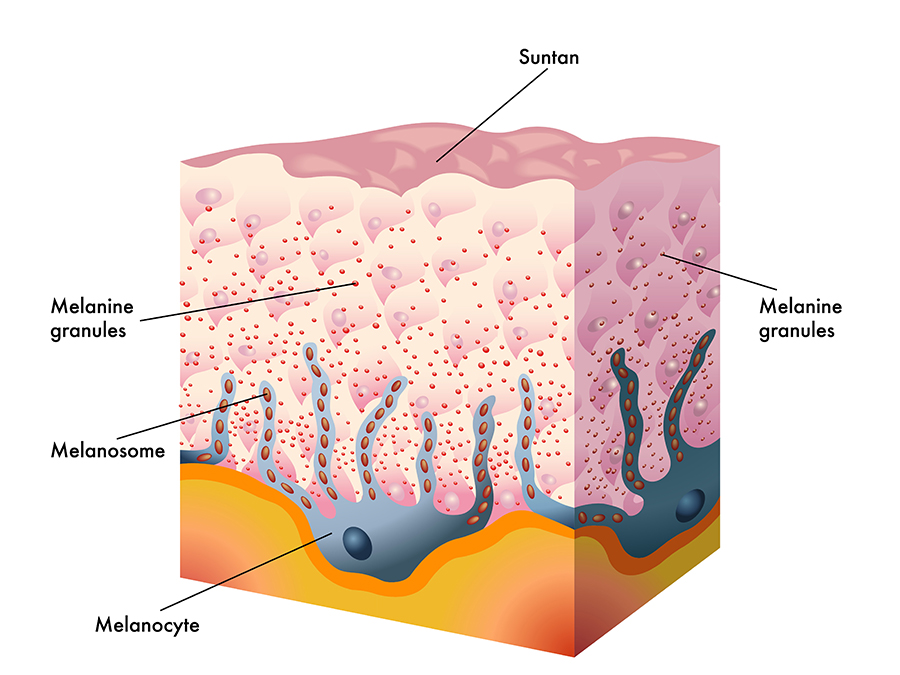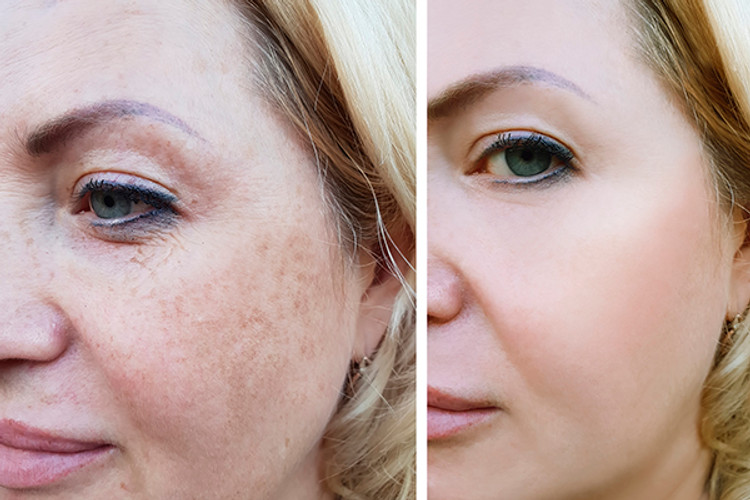Posted by Natalia & Varinia Michalun on 18th Jan 2020
Skin pigmentation and how to repair it.
Pigmentation is a normal process in the cellular activity within the skin. Hyperpigmentation results from an uneven distribution of melanin over the skin surface, either due to pigment accumulation, as in case of age spots and lentigo, or because of uneven melanin production by melanocytes, as in the case of melasma.
The melanocyte cell is located in the basal layer of the epidermis. From there it projects series of ‘tentacles’, each surrounding approximately 36 keratinocytes. Within the melanocytes are the melanosomes that produce melanin. When appropriate new keratinocytes surround a ‘tentacle’ portion of the melanocyte, there is a chemical process by which the melanosomes are able to pass into the keratinocytes. Once in the keratinocyte, the melanosome loses its membrane and releases the melanin. This gives the keratinocytes – and thus the skin – its natural color. Melanine is produced by the tyrosine protein, which is activated by the tyrosinase enzyme in an oxidative environment (i.e., due to free radicals). Therefore, exposure to UV light and the subsequent free radical formation incentives an increase in melanin production. The reaction is also hormonally controlled, which explains why melasma can be result of pregnancy and the use of contraceptives. Prolonged periods of intense stress are also believed to cause melasma in susceptible individuals.

The rate of melanin production varies from person to person and from race to race, being greater in darker-skinned individuals. Melanin acts as a filter, protecting the skin and body against harmful effects of the sun’s radiation. Surface irritation, often caused by sun exposure, triggers increased melanin production, augmenting the amount of pigment in the skin. Therefore, a suntan is basically the body’s protective response against internal skin damage from free radicals.
Lentigo, commonly known as age spots, occurs when there is an uneven accumulation of melanin deposits in the epidermal surface layers. In the case of melasma, or local hyperpigmentation, the pigmentation results when the melanocytes produce a greater amount of melanin in a given area of the skin, and/or when the melanin is not properly absorbed by the keratinic cells. Melasma occurs as a result of hormonal imbalances caused by pregnancy, the use of birth control pills, menopause, or nervous disorders. Dark spots can also be the result of surface irritation of the skin as those caused by acne condition.
The best treatment for pigmentation is based on bleaching agents and ingredients that can help regulate melanocyte activity. Bleaching and skin lightening agents, both botanical and synthetically manufactured, can include all citruses, idebenone, kojic acid, vitamin c, lemon oil, licorice, linden, to name a few. Hydroquinone, a very effective bleaching ingredient, has been removed from the cosmetic ingredient category in a number of countries due to potential melanocyte-damaging effect. Some bleaching agents should only be applied at night, as some of the ingredients tend to react with sunlight and further aggravate the problem.
Key ingredients that regulate melanin production include antioxidants, as these can reduce the free radicals that stimulate melanocyte activity. Such ingredients include alpha lipoic acid, green tea, idebenone, resveratrol, super oxide dismutase, and vitamins E and C. In addition, anti-inflammatory and soothing ingredients are essential in order to reduce potential skin irritation, which also aggravates melanin production. Exfoliating ingredients such as glycolic acid or salicylic acid will help eliminate surface accumulated pigmentation. It is important to avoid provoking strong skin irritation with exfoliating ingredients, as this could aggravate the pigmentation problem.
In all cases, when attempting to correct hyperpigmentation – one of the most challenging skin conditions – it is essential to use a sunscreen with a high SPF at all times during the day, regardless of whether it is sunny or cloudy, summer or winter. Direct sun exposure in the summer should be avoided, as UV light increases the process of oxidation responsible for pigmentation. The use of tanning beds should be avoided, of course.
Failure to use a sunscreen could neutralize whatever result the treating product may give.

